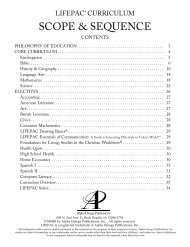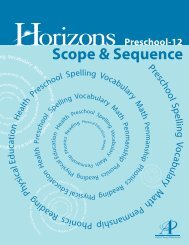Horizons Math Sampler - Odyssey Academy
Horizons Math Sampler - Odyssey Academy
Horizons Math Sampler - Odyssey Academy
Create successful ePaper yourself
Turn your PDF publications into a flip-book with our unique Google optimized e-Paper software.
Lesson 45<br />
<strong>Horizons</strong> <strong>Math</strong> 5 SAMPLE<br />
Concepts:<br />
Two- and three-digit quotient division, division of money, three-digit multiplication,<br />
two- and three-digit subtraction, place value, multiple operations<br />
Objectives:<br />
1. The student will be able to complete division problems which contain three-digit<br />
quotients with remainders.<br />
2. The student will be able to complete multiplication problems which contain a threedigit<br />
multiplier and a one-digit multiplicand.<br />
3. The student will be able to divide money.<br />
4. The student will be able to complete division problems which contain a two-digit<br />
quotient with remainders.<br />
5. The student will be able to complete two- and three-digit subtraction problems.<br />
6. The student will be able to identify place value through the billions.<br />
7. The student will be able to complete problems which require the use of more than<br />
one operation to solve.<br />
Teaching Tips:<br />
By this time, students should have a basic understanding of the division process and all<br />
the steps involved in solving a division problem. Stress that solving a larger division<br />
problem simply means that the same division steps (Divide, Multiply, Subtract, Check,<br />
Bring Down) used in smaller problems, will be repeated in the larger problem.<br />
Tips<br />
Materials, Supplies, and Equipment:<br />
1. Graph paper or lined paper<br />
2. Calculator (for multiplication steps and checking ONLY)<br />
Activities:<br />
1. Remind the students of the steps involved in a division problem (Divide, Multiply,<br />
Subtract, Check, Bring Down). Have them repeat the class acronym if needed.<br />
2. Complete the following problems together for review: 212 ÷ 3 =, 302 ÷ 5 = and<br />
363 ÷ 4 = (Answers: 70 r 2, 60 r 3, and 90 r 3). You may wish to have the students<br />
play “teacher”. Pick a different student to complete each problem. The student<br />
must come to the board, work the problem, and explain each step as he completes<br />
the problem, just like the teacher would. If the student has difficulty with any<br />
portion of the division problem, he may stop at any point and have another student<br />
complete the task.<br />
3. Read Lesson 45 Explanation together. Work through the sample problem and<br />
discuss each step.<br />
4. Use the following problems as additional practice problems, if needed: 2,825 ÷ 3 =<br />
2,457 ÷ 6 = and 2,560 ÷ 4 = (Answers: 941 r 2, 409 r 3, and 640).<br />
5. The student should be able to complete Lesson 45 Practice independently. Allow<br />
them to use graph paper or lined paper, if necessary, to keep all columns straight.<br />
Also allow the students to use calculators for checking and difficult multiplication<br />
problems, but not for calculating answers without showing work.<br />
Aa Bb Cc<br />
2<br />
2<br />
4<br />
God opposes the proud but gives grace to the humble.<br />
Proverbs 3:34<br />
Editor’s Note: Worksheets may be used or repeated in any lesson after they are first suggested.<br />
Worksheet 24 was suggested in Lesson 44 and has been carried forward to this sample<br />
lesson.<br />
53








